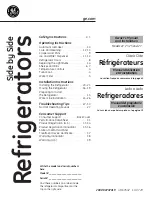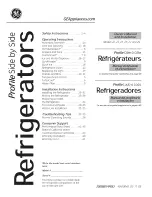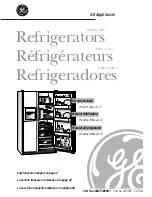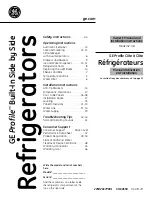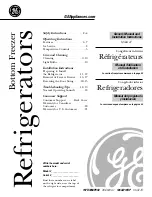
7
GB
- The refrigerator compartment is equipped with convenient,
removable shelves (Fig. 1) which can be adjusted for height
using the shelf guides. This allows you to place even large
items in the refrigerator.
Fig. 1
- For the preparation of food to be frozen, please
- For the preparation of food to be frozen, please
- For the preparation of food to be frozen, please
- For the preparation of food to be frozen, please
- For the preparation of food to be frozen, please
consult a specialized manual.
consult a specialized manual.
consult a specialized manual.
consult a specialized manual.
consult a specialized manual.
- Food that has thawed, even partially, must not be re-fro-
zen: you must cook it in order to consume it (within 24 hours)
or to freeze it once again.
- Fresh foods that you intend to freeze must not be placed in
contact with those that are already frozen or those that have
been fast-frozen. Place the food you wish to freeze in the
top compartment where the temperature will fall below -
18°C, which is ideal for freezing food properly. Please keep
in mind that proper conservation of frozen foods depends on
the speed with which they are frozen.
- During the freezing process, avoid opening the door of the
freezer.
- The maximum daily quantity of food that can be frozen is
indicated on the rating plate located to the left of the vegeta-
ble crisper.
- In order to freeze and then thaw foods optimally, it is rec-
ommended that you divide food into small portions so that
they freeze quickly and uniformly. The packages should be
clearly marked with the content and the date they were
frozen.
- Do not open the freezer door in the event of a power failure
or malfunction. This precaution will slow the rise in tempera-
ture within the compartment. If the door is not opened, frozen
and fast-frozen foods will remain in their current state for ap-
proximately 9-14 hours.
- Do not place full bottles in the freezer: they could easily burst
because all liquids increase in volume when they freeze.
- Fill the ice cube trays about 3/4 full.
- If the room temperature remains below 14°C for an ex-
tended period of time, the temperature needed for extended
storage of food in the freezer will not be reached, resulting
in reduced storage life of the food.
FREEZING FOOD
FREEZING FOOD
FREEZING FOOD
FREEZING FOOD
FREEZING FOOD
Fig. 2
Fig. 3
The side bottle rack can be used either for storing a bottle
(Fig. 2) or several cans (2-4) placed horizontally (Fig. 3). If
not in use, the bottle/can rack can be tipped up and away to
make more room inside the refrigerator.
What Not to Store in the Refrigerator
What Not to Store in the Refrigerator
What Not to Store in the Refrigerator
What Not to Store in the Refrigerator
What Not to Store in the Refrigerator
Garlic (transmits odour), onions and leeks.
Bananas (they will turn black).
Citrus fruits.
Potatoes and root vegetables (store in dark, dry places).
- The door accessories are designed to offer easy use and
flexibility. The easy to remove door shelves make cleaning
simple.
- The 2 shelves situated at the top of the refrigerator can be
used for storage of small food items, such as preserves and
paste etc.
- The top vegetable crispers which are cooler than the
bottom one, are more suited for fruits and vegetables such
as, strawberries, grapes, mushrooms, red tomatoes. Whereas
the bottom crisper is ideal for storing pineapples, avocados
etc.
- To use the meat/cheese box, unhook it and remove it from
the shelf. To optimise space according to your needs, the
same can be moved laterally (Fig 4).
Fig. 4
Содержание HT303
Страница 13: ...13 GB NOTES NOTES NOTES NOTES NOTES ...

















